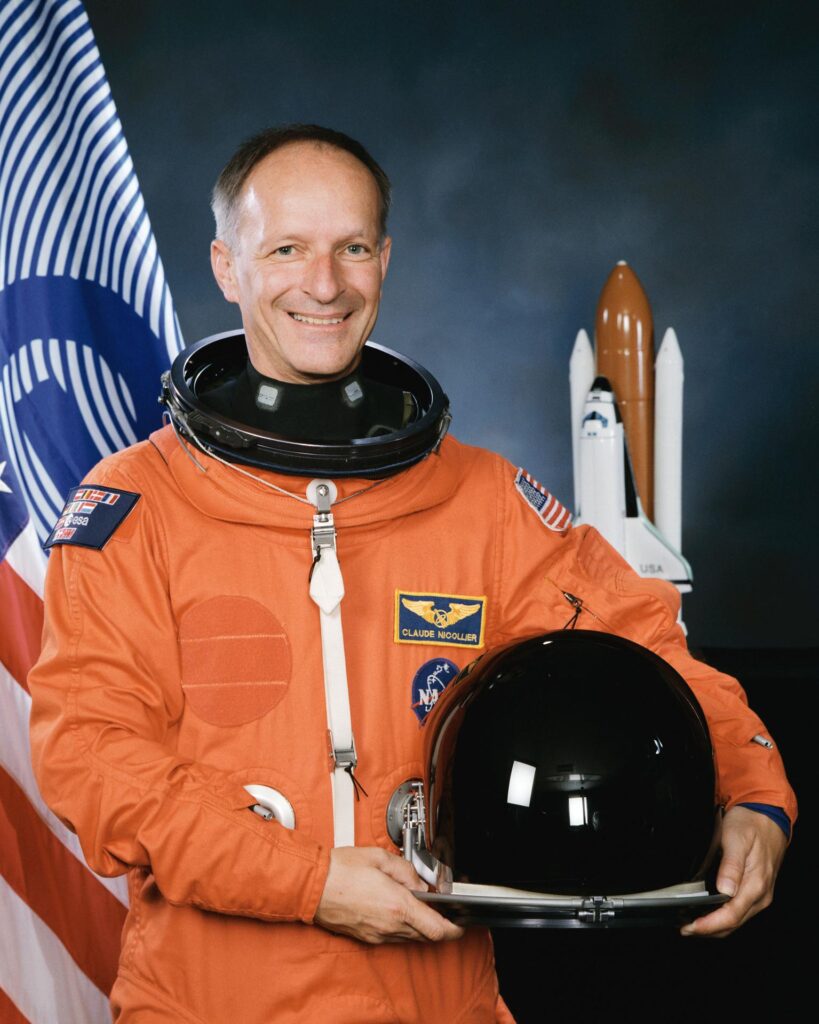Claude Nicollier was born on September 2, 1944, in Vevey, Switzerland. He graduated from Gymnase de Lausanne in Lausanne, Switzerland, in 1962. He received a Bachelor of Science in Physics from the University of Lausanne in 1970, and a Master of Science degree in Astrophysics from the University of Geneva in 1975. Nicollier earned licenses as a Swiss Air Force pilot in 1966, as an airline pilot in 1974, and as a test pilot in 1988.
Beginning in 1975, Claude Nicollier worked as a graduate scientist with the Institute of Astronomy at Lausanne University and at the Geneva Observatory. He then joined the Swiss Air Transport School and was assigned as a DC-9 pilot for Swissair, concurrently participating part-time in research activities of the Geneva Observatory. At the end of 1976, he accepted a Fellowship at the European Space Agency’s (ESA) Space Science Department at Noordwijk, Netherlands, where he worked as a research scientist in various airborne infrared astronomy programs. In July 1978, he was selected by ESA as a member of the first group of European astronauts. Under an agreement between ESA and NASA, he joined the NASA astronaut candidates selected in May 1980 for astronaut training as a mission specialist. Nicollier holds a commission as Captain in the Swiss Air Force and maintains proficiency in the F-5E aircraft. He has over 5,400 hours flying time including 3,800 hours in jet aircraft.
His technical assignments in the Astronaut Office included flight software verification in the Shuttle Avionics Integration Laboratory, participation in the development of retrieval techniques for the Tethered Satellite System (TSS), Remote Manipulator System, and International Space Station (ISS) robotics support. From the spring of 1996 to the end of 1998, he was head of the Astronaut Office Robotics Branch. During 1988, he attended the Empire Test Pilot School in Boscombe Down, England and graduated as a test pilot in December 1988.
Claude Nicollier is a veteran of four space shuttle flights and has more than 1,000 hours in space including one spacewalk of eight hours and ten minutes. He served as a mission specialist on Shuttle missions STS-46, STS-61, STS-75, and STS-103, all of which were launched from Kennedy Space Center (KSC), Florida.
During STS-46 Atlantis (July 31-August 8, 1992) crewmembers deployed the European Retrievable Carrier science platform, and conducted the first Tethered Satellite System (TSS) test flight. Atlantis landed at KSC after completing 126 orbits of the Earth and traveling 3.35 million miles in 191 hours and 16 minutes.
STS-61 Endeavour was the first Hubble Space Telescope (HST) servicing and repair mission. STS-61 launched at night on December 2, 1993. During the flight, the HST was captured and restored to full capacity through a record five spacewalks, an epic accomplishment. After having traveled 4,433,772 miles in 163 orbits of the Earth in 259 hours, 59 minutes the mission ended with a landing at KSC on December 12.
STS-75 Columbia (launched on February 22, 1996) had as principal payloads the reflight of the Tethered Satellite System (TSS) and the third flight of the United States Microgravity Payload (USMP-3). The TSS successfully demonstrated the ability of tethers to produce electricity. The TSS experiment produced a wealth of new information on the electrodynamics of tethers and plasma physics. The crew also worked around the clock performing combustion experiments and research related to USMP-3 microgravity investigations used to improve production of medicines, metal alloys, and semiconductors. The mission was completed with a KSC landing on March 9, after 252 orbits covering 6.5 million miles in 377 hours and 40 minutes.
STS-103 Discovery lifted off on December 19, 1999. During the eight-day mission, the crew successfully installed new instruments and upgraded systems on the Hubble Space Telescope (HST). Enhancing HST scientific capabilities required three spacewalks (EVA) totaling 24 hours and 33 minutes. The mission ended with a night landing at KSC on December 27 after 120 Earth orbits and 3.2 million miles. During the 191-hour mission, Nicollier carried out his first spacewalk, an extravehicular activity (EVA) over eight hours long, while installing a new computer and one of three fine guidance sensors. He was the first ESA astronaut to perform an EVA on a space shuttle flight.
Captain Nicollier is currently assigned to the EVA Branch in the NASA Astronaut Office in Houston, Texas. He has been honored with NASA’s Distinguished Service Medal (2001), Four NASA Space Flight Medals (1992, 1993, 1996, 1999), the Prix d’honneur de la Fondation Pro Aero, Switzerland (1992), the Yuri Gagarin Gold Medal from the International Aeronautical Federation (1994), the Silver Medal from the Académie Nationale de l’Air et de l’Espace, France (1994), the Collier Trophy from the National Aeronautics Association (1994), the Prix de l’Université de Lausanne (1994), and honorary doctorates from the Swiss Federal Institute of Technology, Lausanne, and Geneva University, both in 1994.

